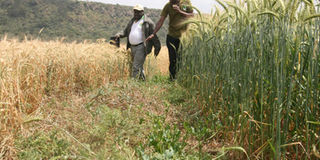How Kenya land system has killed agriculture

A wheat farm in Narok. Labour, inputs and feeds are too expensive and business people seek wide margins compared with dealers in other countries. PHOTO | FILE | NATION MEDIA GROUP
What you need to know:
At independence this elite inherited even more land and became politicians and powerful civil servants.
But while they had the land and the support to farm, they were inefficient producers because they were not full-time farmers.
Instead, they collaborated with the State to create what is today known as “cartels”, which import fertiliser and sell at exorbitant prices, and bring in maize cheaply to make a killing.
While you can easily get an acre of good farmland for between Sh200,000 and Sh400,000 in many parts of the US, you need between Sh1 million and Sh10 million to get the same size in the high-potential areas of Kenya.
CHEAPER IMPORTS
And while the farmer in the US will get subsidies and other incentives, her counterpart in Kenya will instead have to battle, often single-handedly, some of the harshest farming conditions anywhere and, as if that is not bad enough, be saddled with all manner of taxes.
And to break even, she has to sell her produce at prohibitive prices that are no match for cheaper imports from Uganda, Tanzania and even China.
These, and other absurdities, are the reasons Kenya’s agriculture will keep stagnating and the country continue to be fed by its neighbours, experts warn.
“Despite the fact that Kenya and other African economies rely on agriculture, their farmland is not defined and protected,” notes Mr Henry Kinyua, the East Africa head of Digital Green, an organisation that empowers smallholder farmers by harnessing technology and partnerships.
Mr Kinyua, a former Nyeri minister for agriculture, says devolution has made matters worse because of the rapid urbanisation it has triggered in rural areas.
“If there was proper planning, for instance, such cities as Tatu, Migaa, Thika Greens and others, which are sitting on rich agricultural land, would have been elsewhere. Prof Peter Ndege of Moi University’s Department of History traces Kenya’s runaway prices and food security troubles to the Swynnerton Plan of 1954, which allocated land to a few individuals.
“While the Swynnerton Plan was intended to intensify production among Africans, it was also a ploy to prop up a select few of them who would side with the colonial power in the struggle for independence,” explains Prof Ndege, who wrote Agrarian Kleptocracy and the Land Question in Kenya.
CARTELS
At independence this elite inherited even more land and became politicians and powerful civil servants. But while they had the land and the support to farm, they were inefficient producers because they were not full-time farmers.
In most cases, even the big owners really held land for speculation, and not for production, as intended by Roger Swynnerton, the agricultural official after whom the plan was named.
Instead, they collaborated with the State to create what is today known as “cartels”, which import fertiliser and sell at exorbitant prices, and bring in maize cheaply to make a killing.
Meanwhile, the other Africans who were isolated by the plan kept subdividing their land to today’s uneconomical levels. This, and the speculation, has pushed up prices to today’s dizzying levels.
It is also the Swynnerton Plan, Prof Ndege argues, that made Kenya a beverage economy, producing tea and coffee for America and Europe at the expense of food for its citizens.
“The problem with Kenya’s agriculture is simply our collective greed,” concludes Josphat Sirma, a dairy farmer in Rongai.
Labour, inputs and feeds are too expensive and business people seek wide margins compared with dealers in other countries, he says. “Semen here, for instance, costs Sh2,000 when it is imported at Sh400. Why does someone need to make all that profit?” he poses.
So costly are products in Kenya, he says, that for his farm to make a profit he has to import virtually everything.
RENT-SEEKING
A look at the commodity futures this week reveals many Kenyan products are way more expensive than in the international market.
A brewer’s waste costs Sh5 in Kenya while in Uganda it is Sh1.20. In the US, soybean meal goes for Sh36 a kilo while in Kenya it costs Sh75.
Prof Bitange Ndemo of the University of Nairobi says while it may be a little too late to change the country’s land tenure system, the government can tax idle land and stop further subdivision beyond five acres.
“In the US, for instance, the government gives you a contract and asks you to produce so much. They give you loans and if you oversupply and get lower market prices they top up the deficit. If you underproduce they take back the land,” he explains.
The solution to Kenyan farmers’ woes seems far off, with allocations to agriculture consistently kept low (2.9 per cent of the voted expenditure this year) and responses to food insecurity ill-thought-out or designed with rent-seeking in mind, as happened with the Galana-Kulalu irrigation project and the Sh60 billion dams scandal.





